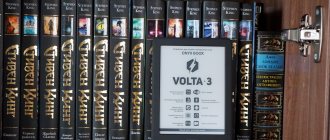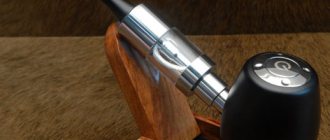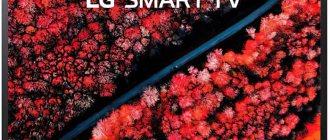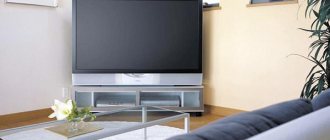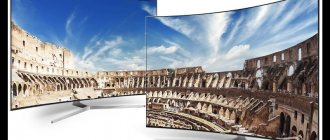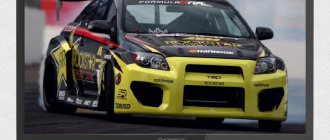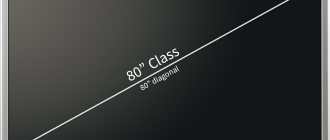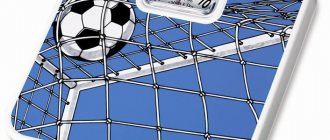Background of the issue
The displays of electronic readers are made using E Ink technology. The image is formed by black and white granules located inside capsule balls with a transparent liquid. They “float” to the top depending on the charge applied to the electrodes. The E Ink display doesn't have LEDs like monitors or tablets, so it's easy to see in daylight. But there is also a drawback - in the dark it is impossible to distinguish text written in “electronic ink”.
Image: Nicolas M / CC BY-SA
The first reader manufacturers supplied their devices without backlights, so reading in the evening required a lamp - as is the case with a regular book. But the situation began to change in 2008. Then Sony released the first reader with backlighting made using front-lit technology. Engineers placed eight blue diodes along the edges of the screen.
The idea was good, but its implementation left much to be desired - the screen was illuminated unevenly. The company received a huge amount of negative feedback both from device users and in the press. One of the residents of the Mobileread thematic forum called Sony’s solution an excellent example of how not to make backlighting in e-readers. The editor of Goodereader noted that the Japanese company's decision left an unpleasant aftertaste and tarnished the entire concept of backlit screens. As a result, Sony management decided to abandon the technology and no longer add it to readers. The head of the IT department of Sony France, Stephanie Lang, admitted in an interview that their backlight really interferes with reading.
For some time there was a lull in the field of backlights for E Ink. Until Barnes and Noble introduced the Nook Simple Touch with Glowlight technology in 2012. The engineers added a special light-conducting layer that scattered the LED radiation, but flare was still visible on the screen.
The problem was solved the same year by Amazon and ONYX. The first introduced the Kindle Paperwhite reader in the USA, and the second introduced the Aurora e-reader in Russia. The developers directed the light of white LED lights into the end of the light guide. This made it appear as if the display was illuminated by an external light source.
ONYX BOOX called the technology MOON Light. It made it possible to read books in any lighting and reduced eye strain, since reflected rather than direct light entered the pupil. As BusinessInsider writes, screen backlighting has become one of the most popular features for e-readers. But the developers of ONYX BOOX and other electronic readers did not stop there and continue to introduce technologies that improve the user experience. One of them was non-flickering backlight.
Comparison table and prices
Choosing the best model from our rating of e-books 2020-2021 is not so easy, to make the task easier for you, we have compiled a comparative table with characteristics and current prices in online stores.
| Model | Screen diagonal, inches | RAM/built-in memory, MB | Battery capacity, mAh | Backlight | Price, rub |
| PocketBook 740 Color | 7,8 | 1024/16384 | 2900 | Eat | 21990 |
| Digma e63S | 6 | n/a/4096 | 1500 | No | 4799-5050 |
| PocketBook 614 Plus | 6 | 256/8192 | 1300 | No | 6400-6999 |
| ONYX BOOX Caesar 2 | 6 | 512/8196 | 3000 | Eat | 5590-6990 |
| Digma s683G | 6 | n/a/4096 | 1500 | Eat | 6350-7218 |
| Amazon Kindle Paperwhite | 6 | n/a/8192 | n/a | Eat | 12590-13990 |
| ONYX BOOX Darwin 3 | 6 | 512/8192 | 3000 | Eat | 7190-8990 |
| Gmini MagicBook A6LHD+ | 6 | 512/8000 | 2800 | Eat | 5800-10809 |
| PocketBook 627 | 6 | 512/8000 | 1500 | Eat | 9470-10990 |
| PocketBook 740 | 7 | 1024/8196 | 1900 | Eat | 14990-155990 |
| ONYX BOOX Gulliver | 10 | 2048/32000 | 4100 | Eat | 38780-39990 |
Flicker-free backlight
The brightness of LED displays is usually controlled using pulse width modulation (PWM). In this case, to control the brightness, the method of pulsating turning the device on and off with changing the pulse duration relative to the signal period is used. If you increase the duration of the pulses without changing their frequency, then more light will enter the eye - it will seem that the brightness has increased. If the pulse duration is shortened, the screen, on the contrary, will look darker.
The circuit is easy to implement, so it is used both in the production of monitors and smartphones, and for backlighting E Ink screens. If the PWM pulse repetition rate is high enough, the human eye does not see flicker. But it still affects the nervous system - fatigue sets in faster, and a feeling of “sand in the eyes” appears. According to an analysis by a team from the Institute of Electrical and Electronics Engineers (IEEE), flickering LEDs can cause headaches and dry eyes, especially while reading a screen. Researchers at the Institute of Environment and Sustainability at the University of Exeter also note that in particularly severe cases, flickering can cause epileptic seizures.
You can eliminate the negative impact if you abandon PWM. In this case, the LEDs are supplied with a constant voltage, and the brightness of the glow is determined by its level. Monitor manufacturers were among the first to introduce this technology. For example, ViewSonic offered flicker-free displays back in 2014.
Light from sources whose brightness is controlled by constant voltage is more comfortable for the eyes, so manufacturers of electronic readers have also adapted it. The engineers from ONYX BOOX were the first to do this - the solution was called MOON Light 2.
The first reader with flicker-free technology was the ONYX BOOX Livingstone with an E Ink Carta Plus screen and a resolution of 1072×1448 pixels. Comfort when reading is added by the SNOW Field function, which reduces the number of artifacts when the image is partially redrawn. Recently, in our blog on Habré, we presented a detailed review of the device.
In the future, flicker-free backlighting will appear in all ONYX BOOX models, including budget readers. It has virtually no effect on the power consumption of the device, so the 3000 mAh battery, which is installed in most ONYX readers, will also last for several weeks.
Backlight temperature control
This is another electronic reader technology that can reduce the strain on the eyes and the human body as a whole.
Experts at Harvard Medical School say that in the evening, blue light shifts circadian rhythms and suppresses melatonin, so reading from a screen before bed can make it difficult to fall asleep at night. At the same time, their colleagues from Oregon State University argue that prolonged exposure to blue light can damage the retina and even brain cells. Modern readers allow you to adjust the backlight temperature. They have two rows of diodes of cold and warm shades, the radiation from which is “mixed” in the light guide and distributed over the screen. Their intensity is independently adjustable. So, you can choose white and yellowish light for reading during the day and evening, respectively.
Many manufacturers offer devices with this feature, such as Kobo and Amazon. But the first reader with “warm” backlighting in Russia was the ONYX BOOX Cleopatra 3. The color gamut in the device is controlled by seven warm and eight cold diodes (their brightness is adjusted individually). Today, similar screens are installed in almost all ONYX BOOX gadgets - from budget James Cook 2 and Caesar 3 to premium models like Monte Cristo 4 and Note 2.
Today, a backlight with the ability to adjust color (Color Temperature Modulation) and powered by a current source is the most progressive in the field of E Ink screens.
But ONYX plans to further develop backlight technologies, improve the quality of light guides and improve the “reading experience” of customers. A few more reviews of ONYX BOOX readers:
- ONYX BOOX Livingstone: a popular format reader in an unusual design
- Around the world with an e-book: review of ONYX BOOX James Cook 2
- ONYX BOOX Faust - those who search are not forced to wander
- Review of ONYX BOOX Max 3: reader with maximum screen
- Test and review of ONYX BOOX Caesar 3: inexpensive reader with premium features
Rating of the best inexpensive e-books 2021
Rating of the best inexpensive e-books 2021
In this article we will provide a rating of e-books for 2020-2021 in the budget category. Many people today are thinking about how to choose an e-book, but there are few precise guides with specific examples on the Internet. Well, let's correct the situation. Let us emphasize that this time we will talk specifically about inexpensive devices – priced up to 10 thousand rubles and with a diagonal of 6 inches. Moreover, we didn’t even look at e-reader models without backlighting. There are such things in nature, but they are no good. The backlight is the most important part of the reader. With backlighting it is more comfortable to read even during the day, not to mention at night. Therefore, we are confident that all e-books in 2021 must already have this option.
Well, let's see what electronic readers you can buy with 10 thousand rubles. In addition, in the sidebars, as a bonus, we will answer a number of popular questions related to gadgets of this kind.
What sizes are e-books in 2021?
Today there are three current form factors of e-books. The first is the classic 6 inches. This format is suitable for ordinary literature. The second is 7.8 inches. On devices of this format it is much more convenient to view books and documents with graphs, diagrams, tables and diagrams, as well as comics and musical notes. The third form factor is with 10.3-inch diagonal screens. On such displays it is as comfortable as possible to study the documents listed above with complex layout. In addition, 10.3-inch e-readers are great for electronic versions of newspapers and magazines.
4th place. Digma R63W
The most simple electronic reader for unassuming users. It is cheap and, logically, does not offer any flashy features. Well, except for the very low price. The E Ink Carta screen has a low resolution of 800 x 600 pixels - the text on it looks like it is on inexpensive “newsprint” paper. The letters are loose and not very clear. With a processor speed of only 600 MHz, the device is quite sluggish, which can be annoying. The list of supported formats includes only 12 items, which is not enough. Without recharging, the model can work from three weeks to a month. This is within the bounds of decency, but not incredibly cool. In general, what you pay is what you get: not much.
Which e-book is best for a child?
For a child (schoolchild or preschooler), we can recommend a simple e-book without a touch screen - like those discussed in this article. Such readers are controlled by buttons and do not have Internet access. As a result, the child will not be distracted by unnecessary entertainment functions, but will focus on reading. What, in fact, is required: an e-book is the best way to introduce a very young person to reading literature.
3rd place. Ritmix RBK-676FL
The model is very similar to Digma, but has a higher screen resolution - 1024 x 758 pixels. Therefore, the clarity of the letters is higher. Although in general the screen quality is far from maximum, as evidenced by reviews of this e-book. Still, the product is budget. On the other hand, if you ask the question “which e-book is better – Digma or Ritmix?”, then the answer is obvious: Ritmix. On the other hand, the model supports the same 12 book formats and has the same 600 MHz processor. Whereas a good e-reader should ideally open one and a half times as many types of books and have a 1 GHz processor. As for the work time, we again have approximately three weeks to a month.
Why is an e-reader better than a smartphone or tablet?
Electronic books have special screens based on electronic ink technology – E Ink. They look like regular paper and are practically harmless to vision. The backlight of such screens does not hit the eyes, since the light flows parallel to the display. Due to this, the eyes are not irritated at all, and vision does not deteriorate. For comparison, the light from color smartphone screens goes directly into the user’s eyes. In addition, unlike the displays of e-readers, the screens of smartphones and tablets glare in the sun and flicker. All this has an extremely negative effect on vision. Therefore, ideally, you should use exclusively e-books for reading. Moreover, they work without recharging for up to 2 months, and not a day or two, like smartphones and tablets.
2nd place. Onyx Boox James Cook 2
The device is more expensive than the same Ritmix model, but it has a much lower quality E Ink screen with a resolution of 800 x 600 pixels. Which is very strange. At the same time, Onyx runs Android. Reviews of e-books usually say that Android is good. However, this is a very misconception, and the best e-readers never use this platform. Android requires a fast and inefficient processor (Onyx has 4 cores, 1.2 GHz), and the Android OS itself willingly wastes battery power in an unknown place. Therefore, the Onyx model can last only a couple of weeks without an outlet. And in terms of operating speed, it is comparable to readers that have 600 MHz processors. Format support for Onyx Boox James Cook 2 is at an average level: 15 pieces. This is better than 12, but not the maximum for the market. Memory 8 GB.
Is it worth buying an e-reader with Android?
The Android operating system is good for smartphones and tablets, but it is not suitable for e-readers. As a rule, e-readers use older versions of Android with unoptimized power consumption. This eliminates one of the main advantages of E Ink screens – ultra-low power consumption. Therefore, a book with Android can work without recharging, for example, up to two weeks. And, say, a reader with Linux OS, which is much more economical, up to two months.
1 place. PocketBook 616
A very successful inexpensive model from the leader of the Russian reader market. It’s worth starting at least with the design - PocketBook 616, unlike the three previous models, does not look like an alien from the past. This is a very nice modern “unit”. The quality of the E Ink Carta screen (resolution - 1024 x 758 pixels) is as high as possible - it is brighter and clearer than those of Digma, Onyx and Ritmix. The device has twice as much memory as most analogues - 8 GB versus 4. The processor is 1 GHz, so the model is also almost twice as fast in operation. The picture is complemented by support for as many as 18 e-book formats - PocketBook readers, including the 616 model, are absolutely “omnivorous”. Finally, there is one more important point: PocketBook e-books are provided with a company warranty of THREE years. Against all year for other brands.
Which e-book should I buy – PocketBook or Kindle?
Amazon Kindle readers are not intended for the Russian market, although they are often mentioned in the information space. They do not have a warranty in Russia and support an extremely small number of book and document formats - only about 6. In addition, in technical terms, Kindle models are quite seriously behind the market. For the US, where they are inexpensive and there are practically no other e-books, Amazon’s models have virtually no alternative. For Russia and the CIS countries, PocketBook readers are the right option. They have a 3-year warranty, they support 20 book and document formats (that is, almost all existing ones), they are generally more technically advanced and modern.
The Best Inexpensive E-Reader in 2021
The optimal choice is the PocketBook 616. This is a very compact model in the most popular 6-inch form factor with backlighting, a fast processor and convenient controls. In addition, the model looks more modern than its analogues, supports the maximum number of formats and is provided with a 3-year warranty. If we compare it with analogues, it turns out that the PocketBook 616 has significantly more significant advantages.
PS And yes, there is one more thing I would like to say. In the summer of 2020, the world's first 6-inch color reader with an E Ink Kaleido screen, the PocketBook 633 Color, appeared on the market. The screen size was enough for reading fiction, but it was not enough for studying educational, entertaining, technical and other content with color illustrations and an abundance of small details (captions on diagrams and diagrams, symbols on geographical maps, text in comic bubbles, and so on).
And in 2021, a new color PocketBook appeared on sale - model 740 Color. This is the first electronic reader both in Russia and in the world, which combines two features at once: an E Ink Kaleido color display and a large diagonal of 7.8 inches. And this is a real revolution in the world of electronic reading! The dimensions and high resolution (1872 × 1404) of the PocketBook 740 Color screen allow you to study any content with or without illustrations with maximum comfort: fiction, documents, magazines, comics, textbooks, encyclopedias, etc. At the same time, E Ink Kaleido screens retain all the properties of black -white E Ink displays: harmless to vision, low power consumption, excellent behavior in the sun.
It would seem, what are these flagship models doing in the ranking of inexpensive e-readers? Firstly, we just decided to talk about them, since many have been waiting for color readers for a long time - and they have finally appeared. Secondly, PocketBook 633 Color and PocketBook 740 Color are inexpensive in their own way: they are only a thousand or two rubles more expensive than their analogues with black and white screens. That is, you don’t have to pay a lot of money for color. The same PocketBook 740 Color costs 21,900 rubles, and a similar model with a black and white screen PocketBook 740 Pro costs 19,900 rubles.
